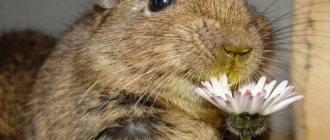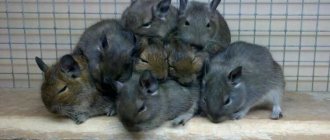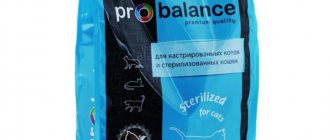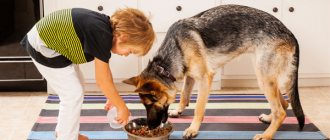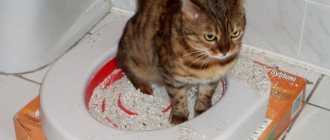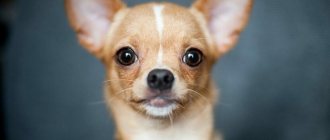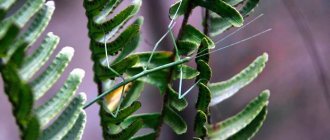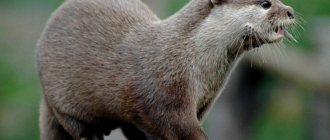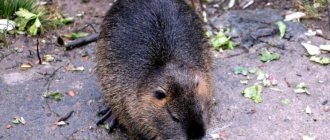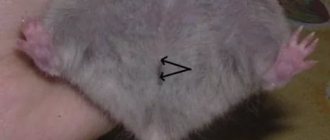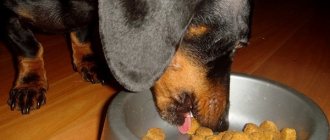The fashion for exotic pets is only gaining momentum today. Cats and dogs won’t surprise anyone anymore. That's why people have hedgehogs and turtles, spiders and scorpions, raccoons, and squirrels in their apartments. Moreover, most often this decision is emotional. I saw a cute little animal and took it home. And the fact that tomorrow it will swing from a chandelier or chew a hole in the parquet floor is something that owners begin to think about as problems arise.
let's get acquainted
If you want a charming perpetual motion machine to live at home, the movement of which is difficult to track (even if you do it very diligently), then it is quite possible that this animal can become a good friend. But for those who expect a calm dormouse creature to live with them, it is better to look for another option.
Degus are small rodents that have short hair and elongated ears. Why have they gained popularity among lovers of exotic animals? First of all, because they do not have any specific smell. At the same time, caring for them is not at all difficult, and they can delight the owner with energy for many years. The Chilean degu squirrel has its own peculiarities of keeping, which every owner should know about, and before this rodent crosses the threshold of his home.
Reviews
Elena Alekseevna, 32 years old, Samara.
About a year ago I acquired a small degu – a boy. I had never encountered squirrel content before. The store where I bought the animal advised me to also buy ready-made food. At home, the little squirrel ate it very reluctantly. Therefore, she began to give him oats, apples and hay, which he dealt with very quickly. Now we are over a year old and we no longer think about ready-made store-bought food.
Sergey Vladimirovich, 41 years old, Ryazan.
Recently a cheerful animal appeared in our family - a degu squirrel. To feed her, we first used a mixture of wheat and rye grains, banana slices and carrots. After about a month, a small bald spot appeared on his back. At first we didn't think it was serious, but it kept growing and we had to go to the vet. The first thing the specialist asked about was the diet of our degu. When he found out what we were feeding him, he advised us to prepare a grain mixture of oats, wheat and rye, and it should contain the most oats. And replace bananas and carrots with apples and cabbage. After 2 weeks of such feeding, the squirrel’s condition began to improve. And a month later there were no traces of the disease left.
Olga Alexandrovna, 25 years old, Moscow.
After purchasing the degu, she struggled for two months with preparing grain mixtures and selecting vegetables and fruits. After which I decided to switch to ready-made food for degus. At first I purchased Versele-laga Degu Nature, but after 2 or 3 weeks of feeding I began to notice that the tip of the squirrel’s tail began to become bald, so I had to give up this food. To replace it, I chose Beaphar XtraVital Degu, the animal ate it very willingly. A month later, the first results became noticeable: the degu’s fur became shiny and smooth, the animal felt great. Now I have chosen this food and I am not going to look for a replacement in the near future.
Peculiar look
At first glance, it is clear that this is not the forest fluffy beauty that we are used to seeing in pictures. But they resemble them in the shape of their head and curved back. The Chilean degu squirrel is usually gray or brown, but these animals can also be red. On the back the hair is longer and coarser. The abdomen is usually lighter - from cream to milky in color.
The main difference from an ordinary squirrel is that this animal does not have a luxurious tail. In degus it is covered with skin, which, with a sharp tug, is removed with a stocking. After this, new skin grows on the base. Adult individuals weigh 300-400 g. Their length is approximately 40 cm including the tail. Domestic pets usually weigh and grow slightly less than their wild counterparts.
The digestion of these animals is quite sensitive, so you need to consult with the breeder and choose the food for degu that he recommends. We'll talk about this in more detail below. The squirrel's vision is not very sharp, but the eyes are located in such a way that they can provide a wide range of vision. The animal has excellent hearing and sense of smell, so it quickly and easily navigates. Moreover, regardless of the time of day and lighting. The animals live quite a long time. In nature, this period is limited to 6-8 years, and at home they often live up to 12 years.
What do degus eat in the wild?
Degus live in South America, mostly in Chile, Argentina, and Peru. This is an equatorial climate zone. There is a very diverse flora here, so the degu stomach accepts a wide range of food.
Under natural conditions, they choose steppe, semi-steppe and rocky areas . For food they use fresh or dry grass, young shoots and some twigs from trees. Cacti are found as a special treat. In our conditions, it will not be possible to replicate the natural diet of the Chilean squirrel, but experts have created a list of possible food based on the elements necessary for the animal’s body.
Habitat
Based on this, you can understand which food is optimal for degus. The exotic nature of these animals lies in the fact that their usual habitat is forests and rocks, deserts and marshy areas of South American countries. They can be found in Chile and Peru, in Brazil. They are also found in some regions of Bolivia.
They began to be imported into Russia as ornamental animals and gained wide popularity. At the same time, many owners only after purchasing begin to think about what food to choose for degus.
Health, disease and prevention
A healthy degu pet is sociable and active. An important indicator of health is clean eyes, without visible foreign stains. Also, orange teeth, if they have begun to lighten, are a reason to adjust the Chilean squirrel’s diet. Even with poor nutrition (an abundance of fiber-rich vegetables and fruits on the menu), the animal may develop diarrhea.
The most common ailments of degus:
- Conjunctivitis. Characterized by the presence of purulent discharge from the eye area. Antibiotic drops are used for treatment as prescribed by a veterinarian.
- Older degu squirrels can suffer from cataracts. The appearance of a white spot on the brown background of a healthy eye is the first sign of the disease.
- Diabetes. A common ailment of improper feeding. Manifests itself in weight gain, lethargy, and increased water consumption. There is no cure for diabetes, but there are preventative measures to prevent its development. Candies, halva and other sweets are unacceptable foods for degus under any circumstances. If the first symptoms are noticed, limit the animal’s consumption of nuts, high-calorie cereals and overripe fruits.
- Colds can also bother the naturally heat-loving degu. The special “enemies” of the health of this furry animal are sudden temperature changes and drafts. If the animal's eyes begin to water, mucus appears near the nose, and apathy is a sure sign that the squirrel is sick. At an early stage, it is treated with traditional methods - a decoction of rose hips and calendula. If it does not help, you need to contact a veterinary clinic.
- Also, contact with sick animals and insufficient cleanliness in the cage can provoke the appearance of skin fungus or parasites.
The main preventive measures are regular cage hygiene and balanced feeding. These are the two “pillars” that will help you avoid all the ailments of your home degu.
To start or not
Keeping an exotic animal at home is not just interesting. It is also a big responsibility. Before you dare and buy a degu, you need to decide whether this creature is right for you. Let's look at the advantages and disadvantages of keeping degus at home.
The following advantages can be highlighted:
- Compared to large animals, rodents consume little food.
- This squirrel doesn't take up much space. Just decide on the location of the cage where it will live.
- Degus are inquisitive, active and sociable animals. Only at first glance they live on their own. With enough communication, the degu becomes strongly attached to its owner.
- The biggest advantage is that the animals do not have a specific smell.
- The squirrel is diurnal, and therefore will not wake you up at night with extraneous noise.
- This is a steppe animal that drinks little liquid and, therefore, produces little excretion. The cage will not have to be cleaned very often.
- Degus are long-lived.
How long do ferrets live at home?
Note that in the wild, domestic representatives of this species will not survive at all. Such animals are simply not adapted to exist in the steppe. How long do ferrets live at home? With proper care and a balanced diet, their life expectancy is 10 years. Although some representatives lived to be 15-18. This is how long domestic ferrets live. There are factors that can reduce the lifespan of an animal by five to six years. These include acquired or hereditary incurable diseases.
But we can say with confidence that keeping animals at home does not shorten the lifespan of animals. Now you know how long ferrets live at home. Of course, all the data given above are statistical averages. Therefore, a lot depends on conditions and nutrition.
We figured out how long a ferret lives. Now we need to highlight the main conditions for the long life of this beast. A lot here depends on nutrition. It should be as balanced as possible. You should always remember about the individual characteristics of your pet. When giving any new product, it is necessary to observe the animal’s reaction. Note that ferrets eat almost everything, but do not forget that they are predators. Therefore, the basis of the diet is meat. You can give these animals beef, offal, chicken, and horse meat. Some types of fish are also allowed, of course, without bones.
If you do not give your pet meat for a long time, then as a result his immunity will decrease, the digestive system will also be disrupted, and it is possible that his hair will fall out.
You can supplement your diet with special vitamin and mineral complexes. You should definitely consult a veterinarian about this. Of course, hygiene also affects the life expectancy of a pet. Ferrets love cleanliness and order. Their cage needs to be cleaned daily, rags and bedding changed. The home should always be warm and, of course, dry. Bowls and drinking bowls must be washed daily.
Things to think about
But not all owners are delighted with their degu. Therefore, it is imperative to keep in mind the negative aspects.
- The squirrel loves to swim in the sand. Therefore, you must be prepared for the fact that you will have to clean not only the cage, but also the space around it.
- Taming a rodent is not at all easy. This is not a cat or a dog. But with proper patience it is quite possible.
- The squirrel loves to try various objects on its teeth. This could be your furniture, shoes, wiring, or other valuable items. It is very difficult to follow while walking; it moves at great speed. Take it in your hands, the animal will slip through your fingers and return to its activities. It is difficult to train, and you should not count on loyalty.
Feeding degus fresh bread
Consumption of fresh bread must be strictly controlled due to the high amount of carbohydrates. You can sometimes (2-3 times a week, not more often) pamper your degu with a small piece of black or white bread (up to 5 grams). As for crackers (of course, not confectionery ones, with sprinkles or raisins/poppy seeds, but homemade ones), they can be in the cage constantly and perform not only a food function (as the main “allowed” source of carbohydrates), but also the function of an object for gnawing : sometimes degus do not eat the cracker, but rather grind it, scattering crumbs around. Preparing croutons for degu is very simple: just cut the bread and lay the pieces out on the balcony or windowsill to dry.
How to choose the right one
If you have weighed the pros and cons, but have not changed your mind about taking this amazing creature with delicate fur and sad eyes, then you need to think about where to get it. You shouldn't go to the poultry market. There is a chance to buy a wild cub. Careless breeders simply purchase several individuals and place them in a large cage. The grown offspring are caught and sold. And since neither they nor their parents have socialization, problems cannot be avoided. Therefore, it is best to look for a good breeder and be sure to visit him.
- Age of the animal. The most important aspect. It is best to take babies 1.5 months old. Food for degus is mainly grain mixtures; we will look at them further below. Previously, they feed exclusively on their mother’s milk, so separation from her is tantamount to death.
- Pay attention to the living conditions of the parents. Is their cage clean, how well-groomed and healthy are the animals themselves?
- Ask your parents about their diet. If they are fed incorrectly, then the risk of developing diseases in babies increases sharply.
- Be sure to pay attention to the behavior of adult animals. If they were kept under normal conditions, they do not run away when a person approaches. On the contrary, the animals show interest and examine everyone who approaches the cage.
- A healthy baby's coat is even and smooth, without bald spots. The eyes are shiny and completely dry. But don’t let the lack of a tassel on the tail bother you, it’s just a feature of its appearance.
Be sure to ask how the animals live. At the age of 1.5-2 months, a young female can already be covered by her own father or brothers. Therefore, as soon as the offspring begins to eat from a bowl (1.5 months), males and females are immediately separated. They feel quite bad when alone, so it is best to keep several individuals of the same sex in each cage.
Feeding for degus
Feeding: gammarus (protein), dry cat food (professional quality - a source of easily digestible fats).
This type of feeding is very good for degus, taking into account the fact that in order to prevent diabetes, their diet is so poor (compared, for example, to the diet of hamsters, rats and other rodents). Gammarus is always available in the pet store (aquarium department) - this is one of the main types of fish food. Gammarus should be purchased dried, but not crushed. Larvae are added 2 times a week to the grain mixture, 10 grams each.
As for dry cat food, it is added to the grain mixture in the same quantity and with the same frequency. However, it is important to choose the right dry food. Under no circumstances should degus be given dry cat food of questionable quality. Often cat food sold in grocery stores and made from by-products and flavoring additives - appetite stimulants - leads to urolithiasis and other diseases.
As a supplement, you can sometimes give your degu a boiled egg (some degus like it) - especially to pregnant or lactating females.
Aviary equipment
Make sure that all the necessary elements are inside the cells. These are houses and burrows; old clay pots can be used as the latter. These are very active animals. So that they have somewhere to put their energy, shelves are installed in the cages at different levels. They are attached very carefully so that the animal does not get hurt during play.
Be sure to install several bowls for food, as well as a drinking bowl. Bedding is a must. To do this, lay white paper on the bottom, and on it a layer of sawdust or pressed corn cobs. Don't forget about a running wheel, a teeth grinding stone and a sand bath for bathing.
Feeding degus with mineral and vitamin supplements
Mineral and vitamin supplements (mineral chewing stones sold in pet stores, chalk, ground eggshells).
Degus love to chew on mineral stones - this is beneficial both for the teeth (they wear down) and for the whole body (a source of microelements). Mineral stones can always be in the cage; replace them as they are chewed. It is important to properly strengthen the stone so that it becomes “appetizing” for the degu - the stone is strengthened with wire on the vertical lattice of the cage or the glass of the terrarium in one of the favorite resting places at the level of the animal’s head. The appearance of such a “growth” of degus is clearly considered an emergency and they try to eliminate it in a short time - “cut it down”. You can also keep chalk and eggshells in the cage at all times. If the animals still do not like to chew on mineral stones and chalk, you can grind the stones and chalk to a powder and add it to the food.
Removing poisonous plants
Any green space can serve as a treat for degus. A squirrel on a walk will basically try everything in the room. Therefore, before purchasing an animal, give away the following plants:
- Sansevieria.
- Dieffenbachia.
- Feronia.
- Flamingo flower.
- Christmas star.
- Indoor Aralia.
- Calla.
If, after all, the animal has tasted any of the listed flowers, it must be urgently shown to a veterinarian. Time is counted in minutes.
Grain mixtures for degu squirrels
Cereal-based feed mixtures must contain carbohydrates and proteins, so they are additionally enriched with dried vegetables, crackers, bread or legumes.
Such mixtures are sold in pet stores, but balanced food specifically for degus is only available imported and they are rare. Therefore, in order to maintain a balanced diet for degus, you can focus on domestic or imported food for guinea pigs or chinchillas. The animals themselves prefer imported food - apparently because it is more aromatic, tastier and has a richer composition. A package of expensive imported food lasts a long time and it is sometimes acceptable to alternate it with domestic food. You can also use only domestic food, provided that it contains all the additional feeds listed below.
How often to feed
So, the newly adopted pet takes its place, it’s time to go to the pet store. Be sure to ask the breeder about what he feeds the degu. Even if the diet was not optimal, you need to gradually transfer the animal to a new food, replacing the usual food by no more than 20% per day.
The optimal method involves split meals. The daily portion should be divided into 3-5 small parts and given throughout the day. In this case, the animal will not feel hungry and scatter food.
How to make a proper diet for your pet
To begin with, it is worth remembering some rules for creating a diet.
- Nutrition should be balanced. To do this, include vitamins and food from the manufacturer.
- Before creating a food list that includes your own ingredients, consult your veterinarian.
- It is impossible to change the diet suddenly, as this can lead to a deterioration in the animal’s well-being. Replace products gradually.
At first, be sure to monitor the behavior of the animal, see what food it likes and what it refuses. However, the Chilean squirrel is a rodent, and it can even eat food that it does not like. Therefore, if there are any changes in your pet's bowel movements or behavior, be sure to contact your veterinarian.
What should be in the feeder
- Grain mixtures for degus. You can make them yourself, including wheat, barley, millet, oats. Pet stores also have ready-made mixtures.
- Be sure to add hay to your diet. In summer, it can be partially replaced with fresh grass, but cannot be completely excluded. Therefore, do your preparations periodically.
- Alfalfa.
- Fresh leaves and flowers of clover, dandelion.
- Leaves, branches and bark of fruit trees. It could be an apple tree, willow, pear, linden.
- Plantain.
- Dried fruits.
Feeding degus hay and grass
Hay (vitamins as well as vital fiber for digestion) and fresh grass (vitamins), dried nettle as a supplement (excellent source of iron), dry and fresh branches, including conifers.
Hay is a very important component of a degu's diet. These are not only vitamins, but also fibers that promote digestion. In addition, hay is a favorite and safe for health “chewing gum”: degus often visit the “hayloft” during the day to rest and refresh themselves. You can buy hay at a pet store or make it yourself. When making hay yourself, in addition to the ecological purity of the meadow, you should pay attention to the composition of the hay in order to prevent the ingress of poisonous plants: henbane, crow's eye, hemlock, milkweed, elderberry, sweet clover, lily of the valley, fern, ivy, buttercup.
It is recommended to include in the hay: dandelion, alfalfa, clover, bluegrass, timothy. It is also better not to add large sedge to hay (it can injure the animal’s oral cavity). To preserve more vitamins, it is better to mow cereal plants during heading, and legumes - just before flowering. For the same purpose, it is recommended to dry the hay in the shade, under a canopy. Young nettles are harvested separately and then added twice a week to hay, or in crushed form to other feeds.
There should always be dry and fresh branches in the degu's cage: both for gnawing and for obtaining additional vitamins. Fresh branches are especially useful in spring, during active sap flow. In summer, fresh branches are given to the animal along with leaves. The favorite branches of degu are: birch, aspen (bark can also be given), willow, apple tree; from shrubs: acacia, rose hips (can be combined with berries). For the treatment of digestive disorders and prevention, from time to time (once a month) it is recommended to give oak bark and branches in small quantities. An additional rich source of vitamins is pine needles (spruce, pine) - given once a week; in the spring, young needles can be given more often. In winter, dry branches and tree bark are good food supplements and gnawing material for degus.
Veterinarian visit to home
When feeding degus vegetables, fruits and herbs, there is one very specific feature of the degu that needs to be taken into account. Animals love to “wither” grass, fruits, and vegetables. A piece of fresh apple is, of course, appetizing for a degu, but it will be of much greater interest to the animal the next day. Don't worry about this and don't remove untouched vegetables, grass and fruits from the cage right away (of course, before they can go bad). Degus usually do not bury grass, vegetables and fruits in the bedding (as they do with nuts or cat food), so it is clearly visible when harmless drying turns into rotting.
Treat for a squirrel
Treats should be given in minimal quantities so as not to harm the degu’s digestion. These can be rose hips and hawthorn berries, chamomile and dry corn kernels. Do not delude yourself that the animals are gnawing them with pleasure. In large quantities they will only add to health problems. The same list can include chokeberry fruits, hazelnuts, pumpkin and sunflower seeds.
But the easiest way is to use ready-made approved degu food. If the store does not have a specialized one, you can take a composition intended for chinchillas or guinea pigs. If they contain additives such as raisins, dried apricots, dates, then they must be removed so as not to expose your pet to the risk of developing diabetes.
Feeding degus fresh vegetables and fruits
Fresh vegetables and unsweetened fruits (vitamins, microelements). For degus, fresh vegetables and unsweetened fruits are the main safe source of vitamins and microelements. As for vegetables, it is recommended to give zucchini, zucchini, cauliflower, and lettuce without restrictions.
Carrots should be given in limited quantities due to the sugar they contain; young carrots are best.
You can give cucumbers to degus (a little, so as not to provoke digestive upset), but, as a rule, the animals do not really like these vegetables.
Many breeders are wary of giving degus regular white cabbage (it can lead to digestive upset). The author does not share this opinion: in the case of white cabbage, the animals know their limits well, and the vegetable contains quite a lot of vitamins with a minimal amount of sugar harmful to degus.
It is also not recommended to give beets in large quantities.
You can give pumpkin, but not much (sugar).
You can't give raw potatoes, boiled potatoes (without sugar and salt) - a little is ok, but animals usually don't like potatoes.
It is better not to give tomatoes, as the vegetable can be a strong allergen for degus.
You can give fresh corn (half a handful every other day).
Fruits that are safe for degus are primarily fresh, unsweetened apples and pears. Young apples of the Antonovka and Semerenko varieties (usually the cheapest on the market) are best suited. Imported apples are usually too sweet for animals.
As for citrus fruits, degus can be given them in very small quantities (half an orange slice no more than once every three to four days).
Bananas, peaches, nectarines, apricots, mangoes, etc. are not recommended at all.
Kiwi can be given a little more often if the animal likes the fruit and does not cause allergies.
Figs, persimmons, etc. can be given fresh, but like bananas and peaches, in very small quantities due to their high sugar content.
Experts recommend
Among the abundance of offers, there are several proven brands that have passed all the necessary research.
- Food for degu Versele Laga. This is one of the few manufacturers that produces truly high-quality and safe food. The composition of the product is transparent and understandable; there is nothing unnecessary in the packaging. One protein accounts for 30 g per day. Do not forget that, in addition to the factory composition, it is necessary to give your pet grass, hay, and roots. This food is the basis, as it has the most interesting and varied composition. Versele-laga Crispy pellets Chinchillas&Degus, Versele-laga Complete Chinchilla & Degu are optional.
- Little One degu food is a complete food with added vitamins and minerals. They are balanced according to the degu's needs. The diet is high in fiber, which is necessary for proper digestion of animals. Consists of grass pellets, crushed grains, vegetables, alfalfa, apple and carob.
If your pet has health problems, it is recommended to consult a specialist so that he can tell you what to feed your degu.
The best food from manufacturers
If you don’t want or don’t have time to prepare your pet’s food yourself, use store-bought food. They are very similar in composition and also contain all the necessary microelements for the health of the animal. Ask the seller which food is best to buy.
Among the recommended ones are the following:
- Essentials chinchilla food.
- Feed mixture for degu squirrels.
- Science Selective Degu.
Don't forget to feed your pet vitamins and mineral supplements.
Carefully monitor the behavior of your animal, because degus are prone to frequent gastrointestinal disorders. If there are changes, it means the food is not suitable. Consult your veterinarian and change your diet. Don’t be lazy when choosing the right food for your degu, because health comes first.
